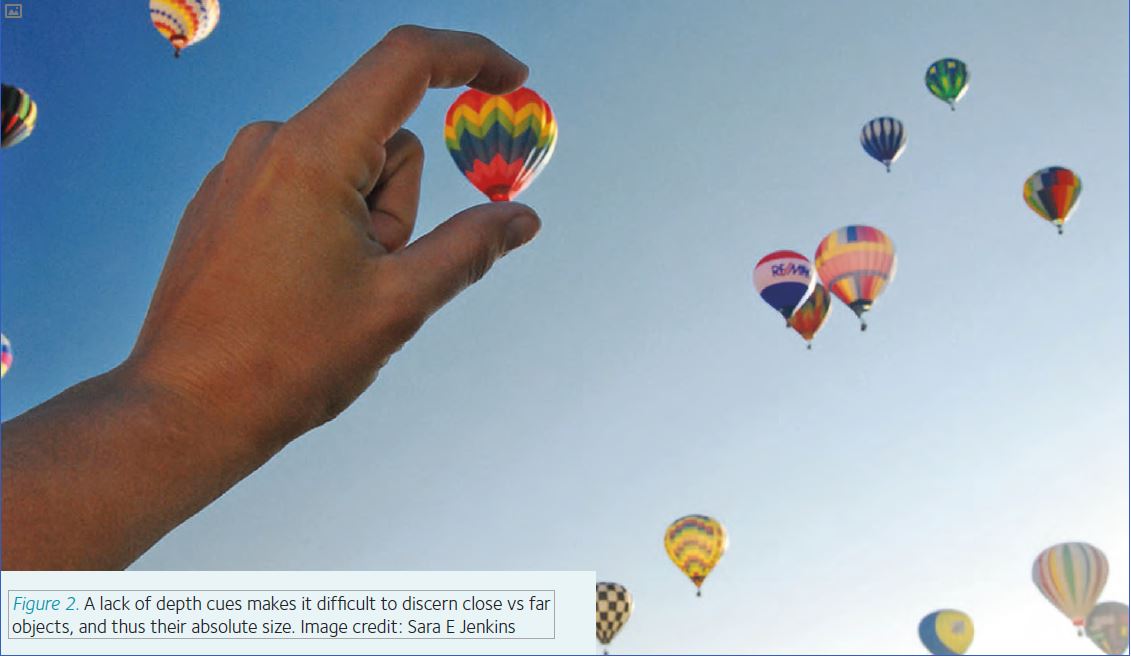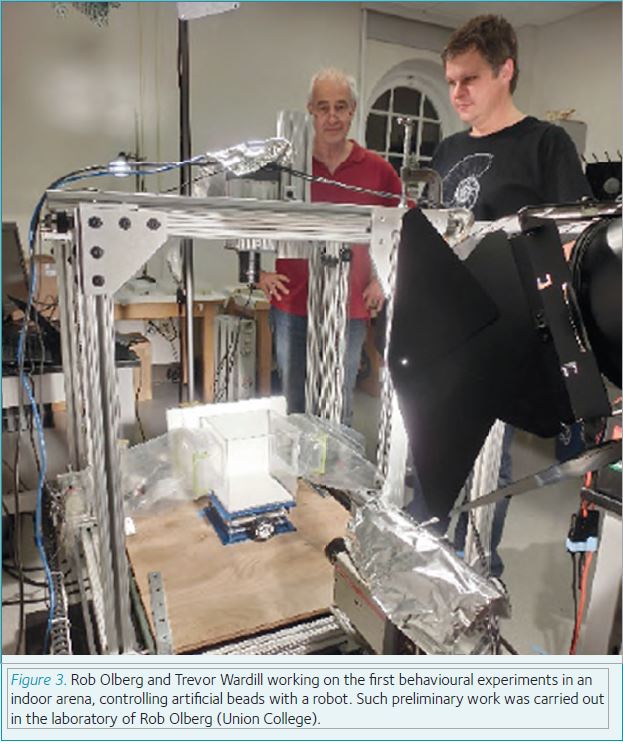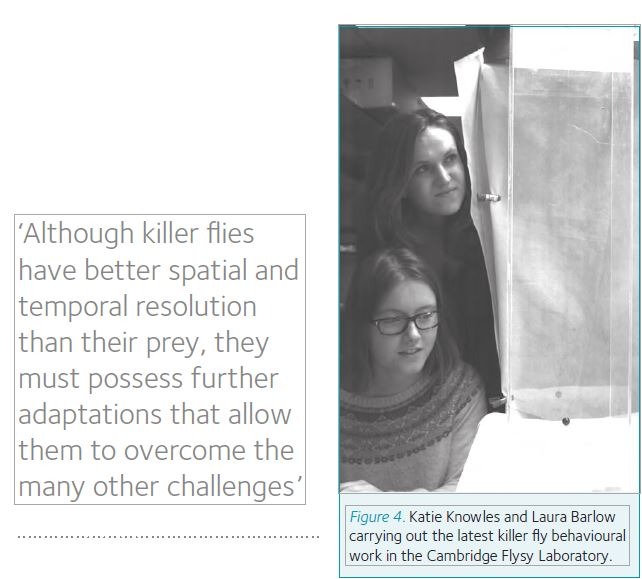
Physiology News Magazine
How visually driven tiny predatory flies achieve elite performance – my adventure from PhD student to PI
Understanding elite neural performance can be a sizable problem
Features
How visually driven tiny predatory flies achieve elite performance – my adventure from PhD student to PI
Understanding elite neural performance can be a sizable problem
Features
Paloma Gonzalez-Bellido
Department of Physiology, Development and Neuroscience, University of Cambridge, UK
https://doi.org/10.36866/pn.102.18

When we think about survival of the fittest, we imagine the power displays of lions, sharks and crocodiles, the pompous feather shows of peacocks and birds of paradise, the rugged agility of mountain goats or the speed of a cheetah. Such abilities raise a simple yet difficult to answer question that burns at the core of every physiologist: what adaptations allow a given animal to achieve the observed performance?
Technological development and ingenuity in the last 50 years has allowed scientists to understand how some animals survive extreme temperatures, salty environments, and even severe restrictions of water, oxygen and energy. We have also started to unravel which compounds and neural circuits play a role in the outcome of specific but complex behavioural interactions, such as the neuromodulators and circuits implicated in
the fight or flight response. However, when it comes to understanding elite neural performance we face a sizable problem: framework and interpretation. Recent advances in technology and genetic modification developed for classic model animals now allow us to visualize neural activity simultaneously across many neurons in a brain with evermore increasing precision. But such tools do not help us interpret the data correctly. When recording from a neuron in a given model system, how can we tell if the information transfer value is at the limit of possible performance or a cheap but functional shortcut?
A comparative approach might be useful
I first faced a similar question early during my PhD. With to the outlook of having a long scientific career, I decided that the best strategy was to study a topic that I am utterly passionate about (visual systems) and learn challenging and current techniques in a model animal (in vivo fruit fly intracellular recordings). Alas, after 1 year of experiments, it was clear that the genetic tools available were causing spurious side effects on the cells of interest and I abandoned such approach. As one of my PhD goals, I had successfully measured the spatial resolution of the photoreceptors in the wildtype fruit fly eye, but on its own, the data seemed meaningless. Although the dogma in the field stated that a small compound eye cannot achieve good resolution due to the size of the lenses (think diffraction limit), the resolution value that I recorded was twice as bad as predicted by the available model. My result was difficult to explain. Given the impasse, I decided that a comparative approach would be fruitful. After all, no one else had carried out such recordings in other small fly species, how could we know how good or bad that resolution was or even if my recordings made sense? I needed a framework, at least one further point for comparison!

Killer flies are fascinating and exhibit elite skills
I thought that a tiny predatory fly (extreme pressure for visual performance in the same body size as a fruit fly) would help me understand the true limit of visual resolution in a small dipteran. On the face of it, it seemed like a farfetched idea, but one thing that I had learnt during my undergraduate years in Australia is that if something is at all possible, there is an animal out there doing it. I took to the internet and found that killer flies met the conditions. Luckily, one of the groups that had worked with killer flies for biocontrol purposes was based near my hometown in Spain; and I was also supposed to fly home for my sister’s wedding. The adventure had started! Before the wedding, my collaborator and husband Trevor Wardill and I escaped, drove for 3 hours to meet the contacts, see the field site and collect the flies. We were amazed when we witnessed for the first time the killer fly behaviour. They hunted so fast that it was difficult to see them fly, so efficiently that there was little prey around. So they just sat there, waiting for the next potential dinner to fly by, unfazed by our presence.
Collecting them was not the challenge, keeping them alive was! Their predatory habit meaning they had to be kept in separate vials. Thus, the top level of my parents’ house quickly filled with flies, food, vials, pooters (devices to catch small insects), etc. After the wedding, and still on good terms with my family, we took the flies to the laboratory. First, I recorded from their photoreceptors. The results blew us away. These flies had a spatial resolution three times better than that of fruit flies. Since the size of killer flies lenses were the same as those of the fruit fly, diffraction could not be the limiting factor, at least not for fruit flies. But that was not all. We also found that their photoreceptors were three times faster. The tighter, much narrower, beautiful recordings from the killer fly eye evidenced that higher resolution was possible in such small animals, and that we could record it. Such finding also gave me a breath of relief from the possibility that my original fruit fly results were caused by damage inflicted to the optics during the dissection.
Unusually small photoreceptors triple visual acuity
There is extensive literature in the field, stating that the two other factors that could affect the spatial resolution at the level of the retina are the focal length of the lens and the size of the light detector, but after measuring the focal length, I found that it was similar between both species. Thus, I took to transmission electron microscopy. There, it was clear: the rhabdomeres – highly folded membranes in the photoreceptors that hold the light sensitive rhodopsin molecule and act as light guides – were three times smaller in killer flies than in fruit flies. This difference fully explained the physiological result. Moreover, the photoreceptors were absolutely packed with mitochondria, a hint to the energy supply requirements of the fast but ATP-hungry killer fly photoreceptors.

The PhD finished and the story published (Gonzalez-Bellido et al., 2011), I later received the Neuroethology Capranica Prize for such work, which spurred me to continue investigating the elite performance of this average looking and tiny fly. Although killer flies have better spatial and temporal resolution than their prey, to be a successful hunter, they must possess further adaptations
that allow them to overcome many other challenges, which seem unattainable with such small body size. For example, it is reasonable to assume that before attacking an animal, a predator would need to know the size of a potential prey and how far away it is. Humans and other predatory mammals do this through the stereopsis provided by the disparity between the two eyes. Here, the high resolution retina and the space between the two eyes is fundamental. Killer flies lack both. How do they know what to go for?
Killer flies attack large beads that can not possibly be of suitable size

By this time we were postdocs in the USA, working on other projects, so we carried this work on our own time (finding the flies there required even more convoluted adventures). Together with our collaborator Rob Olberg, and armed with beads of different sizes and fishing line we headed to the hunting site during a sunny weekend. It was a crazy fun day. Most excitingly, as long as we moved the beads fast enough, killer flies would attack our large beads, which were up to 13 mm in diameter!
The behaviour was reminiscent of that described in a classic paper in the 70s. Collett and Land (1978) had shown that hover flies do not compute absolute size of their target, but that this is a suitable strategy because they only care about chasing conspecifics, the male ‘chaser’ can count with the female ‘target’ being a particular size and flying at a particular speed. Could killer flies be employing a similar strategy? Since killer flies do not have great resolution, they can only detect suitably small prey items when they are relatively close. Of course, detecting a prey only when it is close puts a premium on reaction time because its image crosses the retina very quickly. Indeed, by using two high-speed video cameras and reconstructing their flights, we found that the average distance at which killer flies initiate an attack is only 8 cm, and that they do not carry out any movement, body or head, before the attack is initiated.
Thus, all our data suggested that killer flies lack foveating movements and that these animals simply cope with the uncertainty of not knowing the exact size and location of their prey, using the probability of it being the correct target for deciding to launch the attack. To test this, a rigorous laboratory experiment was set up. By then we were newly established PIs in Cambridge, so the task was given to two brilliant undergraduate students in the laboratory, Laura Barlow and Katie Knowles. They tested a range of different bead sizes, presented at different speeds at different distances.

Their consistent and careful work yielded results that supported our preliminary observations. Killer flies make use of relative cues and lack absolute knowledge about the size or location of their potential prey. Independent of distance to the prey, we found that the ratio between the subtended speed and size of the prey predicted well the probability of attack, and that only after the flight had started, did the flies decide to turn around and return to their perch when then bead size was not suitable. We also found that although the probability of attack was 0.9 when the ratio was optimal, the slope decreased slowly, creating a ‘broad matched filter’, where the probability of attack is generally high, but highest when the ratio is optimal (Wardill et al. 2015).
We continue to work with killer flies, and we have expanded our study to other small flies too… after all, we still need the framework and the more comparative points we get the higher our chances that we would truly get to understand how such tiny visual systems can display elite performance, leading to a behaviour that first appears supernatural. We of course aim to transfer all the latest imaging techniques to such species, and look forward to a bright future, where classic neuroethology, model systems and technological advances are integrated, producing knowledge that amounts to more than the sum of the parts.
References
Collett TS, Land MF (1978). How hoverflies compute interception courses. J Comp Physiol 125, 191-204
Gonzalez-Bellido PT, Wardill TJ, Juusola M (2011). Compound eyes and retinal information processing in miniature dipteran species match their specific ecological
demands. Proc Natl Acad Sci 108, 4224-4229
Wardill TJ, Knowles K, Barlow L, Tapia G, Nordström K, Olberg RM, Gonzalez-Bellido PT (2015). The killer fly hunger games: Target size and speed predict decision to pursuit. Brain Behav Evol 86, 28-37
